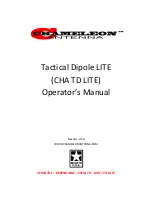
CHA TD LITE
Page 4
reflected from the Earth to the ionosphere again during multihop propagation for longer range communication.
The most important thing for the operator to understand about HF radio wave propagation is the concept of
Maximum Usable Frequency (MUF), Lowest Usable Frequency (LUF), and Optimal Working Frequency (OWF). The
MUF is the frequency for which successful communications between two points is predicted on 50% of the days of
in a month. The LUF is the frequency below which successful communications are lost due to ionospheric loses.
The OWF, which is somewhere between the LUF and around 80% of the MUF, is the range of frequencies which
can be used for reliable communication. If the LUF is above the MUF, HF sky wave propagation is unlikely to occur.
The HF part of the Radio Frequency (RF) spectrum is usually filled with communications activity and an
experienced operator can often determine where the MUF is, and with less certainty, the LUF by listening to where
activity ends. The operator can then pick a frequency in the OWF and attempt to establish contact. Another
method is using HF propagation prediction software, such as the
Voice of America Coverage Analysis Program
(VOACAP)
, which is available at no cost to download or use online at
. The operator enters the
location of the two stations and the program show a wheel with the predicted percentage of success based on
frequency and time. ALE, which is the standard for interoperable HF communications, is an automated method of
finding a frequency in the OWF and establishing and maintaining a communications link.
Even under optimal conditions, there is a gap between where ground waves end (around 40 to 90 miles) and the
sky wave returns to Earth on the first hop (around 300 miles). NVIS propagation can be used to fill this gap. The
frequency selected must be below the critical frequency, so NVIS is can normally only be used on frequencies from
around 2 to 10 MHz. Frequencies of 2
–
4 MHz are typical at night and 4
–
8 MHz during the day.
Parts of the Antenna
The CHA TD LITE is comprised of the following components, see plate (1):
a.
Matching Transformer, EMCOMM
II
The EMCOMM II Matching Transformer, see plate (2), provides impedance matching for the CHA TD LITE.
b.
Antenna Wire
The Antenna Wires are two 60 foot lengths of black insulated wire, wrapped around Line Winders (e).
c.
Isolation loop
Two Isolation loops, one at each end, are permanently attached to the Antenna Wires (b).
d.
Carabiner
The Carabiners are removable pear-shaped stainless steel hooks with a spring-loaded gate.
e.
Line Winder
The Line Winders are used to store the Antenna Wires (b). They enable rapid deployment and recovery of the
CHA TD LITE.
f.
Stakes
(not supplied)
Two tent stakes
(not pictured, not supplied)
are used to anchor the ends of the CHA TD LITE to the ground,
depending upon the antenna configuration.




































